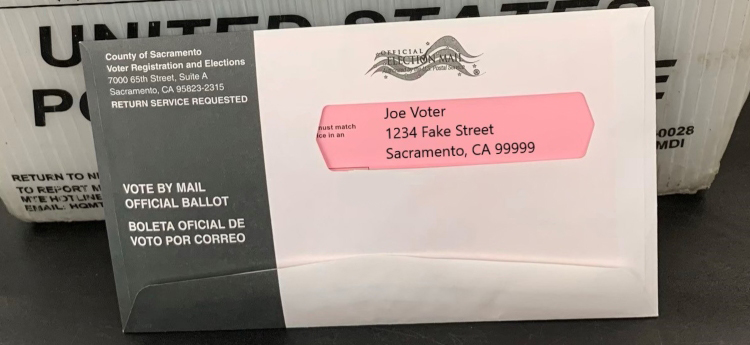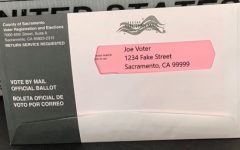
Sacramento County Vote by Mail Official Ballot. (Photo: Saccounty.net)
California Rules for Forms and Order of Ballots
No title or degree can appear on the same line on a ballot as a candidate’s name
By Chris Micheli, February 20, 2022 8:04 am
The California Elections Code provides extensive rules for the forms and order of ballots, which are contained in Division 13, Chapter 2 in Sections 13100 – 13121. Section 13100 requires all ballots used in all elections to be governed by this chapter.
Section 13101 provides that, in the case of the prevention of an election in any precinct by the loss or destruction of the ballots intended for that precinct, the inspector or other precinct officer for that precinct must make an affidavit setting forth the fact and transmit it to the Governor. Upon receipt of the affidavit, the Governor may, and upon the application of any candidate for any office to be voted for by the voters of that precinct the Governor must, order a new election in that precinct.
Section 13102 requires all voting to be by ballot. There must be provided, at each polling place, at each election at which public officers are to be voted for, one form of ballot for all candidates for public office, except that, for partisan primary elections, one form of ballot must be provided for each qualified political party as well as one form of nonpartisan ballot.
At partisan primary elections, each voter not registered disclosing a preference for any one of the political parties participating in the election must be furnished only a nonpartisan ballot, unless the voter requests a ballot of a political party and that political party, by party rule duly noticed to the Secretary of State, authorizes a person who has declined to disclose a party preference to vote the ballot of that political party.
Section 13103 requires every ballot to contain all of the following:
- The title of each office, arranged to conform as nearly as practicable to the plan set forth in this chapter.
- The names of all qualified candidates, except in specified instances.
- The titles and summaries of measures submitted to vote of the voters.
Section 13104 provides that, if a candidate changes his or her name within one year of any election, the new name must not appear upon the ballot unless the change was made by either marriage or decree of any court of competent jurisdiction.
Section 13105 specifies that, in the case of a candidate for a voter-nominated office in a primary election, a general election, or a special election to fill a vacancy in the office of United States Senator, Member of the United States House of Representatives, State Senator, or Member of the Assembly, immediately to the right of and on the same line as the name of the candidate, or immediately below the name if there is not sufficient space to the right of the name, there must be identified, as specified by the Secretary of State, the designation made by the candidate.
Section 13106 specifies that no title or degree can appear on the same line on a ballot as a candidate’s name, either before or after the candidate’s name, in the case of any election to any office.
Section 13107 provides that, with the exception of candidates for Justice of the State Supreme Court or court of appeal, immediately under the name of each candidate, and not separated from the name by any line, only one of the following designations may appear at the option of the candidate:
- Words designating the elective city, county, district, state, or federal office which the candidate holds at the time of filing the nomination documents to which he or she was elected by vote of the people.
- The word “incumbent” if the candidate is a candidate for the same office which he or she holds at the time of filing the nomination papers, and was elected to that office by a vote of the people.
- No more than three words designating either the current principal professions, vocations, or occupations of the candidate, or the principal professions, vocations, or occupations of the candidate during the calendar year immediately preceding the filing of nomination documents.
- The phrase “appointed incumbent” if the candidate holds an office by virtue of appointment.
The Secretary of State and any other elections official are prohibited from accepting a designation of which any of the following would be true:
- It would mislead the voter.
- It would suggest an evaluation of a candidate, such as outstanding, leading, expert, virtuous, or eminent.
- It abbreviates the word “retired” or places it following any word or words which it modifies.
- It uses a word or prefix, such as “former” or “ex-,” which means a prior status. The only exception is the use of the word “retired.”
- It uses the name of any political party, whether or not it has qualified for the ballot.
- It uses a word or words referring to a racial, religious, or ethnic group.
- It refers to any activity prohibited by law.
If the elections official finds the designation to be in violation of any of the restrictions set forth in this section, the elections official is required to notify the candidate by registered or certified mail return receipt requested, addressed to the mailing address provided on the candidate’s ballot designation worksheet. A candidate has three days to appear and provide a designation that complies with the law.
The designation remains the same for all purposes of both primary and general elections, unless the candidate, at least 98 days before the general election, requests in writing a different designation which the candidate is entitled to use at the time of the request.
Section 13107.3 provides that a candidate who submits a ballot designation must file a ballot designation worksheet that supports the use of that ballot designation by the candidate, in a format prescribed by the Secretary of State.
The ballot designation worksheet must be filed with the elections official at the same time that the candidate files his or her declaration of candidacy. In the event that a candidate fails to file a ballot designation worksheet, no designation may appear under the candidate’s name on the ballot.
Section 13107.5 states that a candidate’s ballot designation as “community volunteer” constitutes a valid principal vocation or occupation subject to specified conditions.
Section 13108 provides that, at the first elections for Representative in Congress, State Senator, Member of the Assembly, and Member of the Board of Equalization, that candidate who is deemed the incumbent in a given district for purposes of the election must be that candidate who is running for the same office that he or she then holds, and who is running for reelection in a district that has the identical boundaries and number as the district from which he or she was last elected.
Section 13109 requires the order of precedence of offices on the ballot to be as listed for those offices and measures that apply to the election for which this ballot is provided. Section 13109.5 allows the elections official to list the offices specified directly after the offices specified, when the offices specified in those subsections are on the ballot, or at the end of the ballot in elections at which the offices specified are not listed on the ballot.
Section 13109.7 requires the county elections official for the County of Los Angeles to conduct elections using the alternate ballot order described in law. There are details rules contained in this code section.
Section 13109.8 requires the order of precedence of offices on the ballot to be as listed for those offices and measures that apply to the election for which the ballot is provided.
Section 13109.9 allows the county elections official for the County of Los Angeles to use the alternate ballot order for elections conducted after the completion of the pilot project.
Section 13109.10 provides that, when a special election to fill a vacancy in the State Senate, State Assembly, United States House of Representatives, or United States Senate is consolidated with the regularly scheduled election for that office for the term following the term in which the vacancy occurred, the order of precedence of offices on the ballot for the County of Los Angeles are to be as listed in this section.
Section 13110 states that the group of names of candidates for any partisan office, voter-nominated office, or nonpartisan office must be the same on the ballots of all voters entitled to vote for candidates for that office, except that in partisan primary elections, the names of candidates for nomination to partisan office must appear only on the ballots of the political party, the nomination of which they seek, and candidates for election to a political party committee must appear only on the ballots of the political party for which the candidate seeks election.
Section 13111 requires that candidates for each office to be printed on the ballot in accordance with specified rules in this code section.
Section 13112 requires the Secretary of State to conduct a drawing of the letters of the alphabet, the result of which shall be known as a randomized alphabet. The procedure to be used is specified in this code section.
Section 13113 provides that, in the case of an election of candidates in a special district, school district, charter city, or other local government body, the official responsible for conducting the election is required to notify, at the same time that the election is called, the Secretary of State by registered mail of the date of the election, the date of the close of filing, and the last possible date for filing in the event there is an extension of filing due to an incumbent failing to file. The Secretary of State shall conduct a randomized alphabet drawing on the first weekday following the last possible day of filing in the event there is an extension for the election.
Section 13114 provides that, at any regular meeting of a city council held prior to the date on which the Secretary of State conducts the randomized alphabet drawing applicable to the regular municipal election, the city council may, by resolution, provide for the rotation on the ballot of the names of candidates for any elective city office.
Section 13115 provides that the order in which all state measures that are to be submitted to the voters must appear on the ballot is as follows:
- Bond measures, including those proposed by initiative, in the order in which they qualify.
- Constitutional amendments, including those proposed by initiative, in the order in which they qualify.
- Legislative measures, with exceptions, in the order in which they are approved by the Legislature.
- Initiative measures, in the order in which they qualify.
- Referendum measures, in the order in which they qualify.
Section 13116 states that, in an election at which state, county, city, or other local measures are submitted to a vote of the voters, all state measures are required to be numbered in numerical order. All county, city, or other local measures must be designated by a letter, instead of a figure, printed on the left margin of the square containing the description of the measure, commencing with the letter “A” and continuing in alphabetical order, one letter for each of these measures appearing on the ballot.
An elections official may commence designating local measures with any letter of the alphabet following the letter “A,” and continuing in alphabetical order, in order to avoid voter confusion that might result from different local measures carrying the same letter designation in successive elections.
Section 13117 provides that all state measures in all elections at which state measures are submitted to a vote of the voters are required to be numbered in a continuous sequence, commencing with the number “1” and continuing in numerical sequence for a period of 10 years from the year of commencement.
Section 13118 specifies that the following rules apply when a person who is a candidate for an office believes that another person with a name that is so similar that it may be confused with the candidate’s name has filed or will file a nomination paper for the same office: The candidate may, at the time of filing the candidate’s nomination paper, or within five days after the time for filing nomination papers has expired, file with the elections official a statement that is required to be in substance as follows:
“I ____, believe that another person, whose name is so similar to mine that it may be confused with mine, has filed or will file a nomination paper for the same office for which I have filed a nomination paper, and I therefore request and direct that the elections official assign a number to each candidate with a similar name to be printed on the ballot as a distinguishing mark.:
In addition to the designated numbers that the elections official must place on the ballot when the above conditions are met, the elections official must place on the ballot, immediately preceding the names of the candidates to be voted upon, or on the contest header if there is not sufficient space immediately preceding the name, the following warning:
“Warning! There are two (or applicable number) candidates for this office with identical names.”
This warning must also be included, in a prominent manner, on any state voter information guide, county voter information guide, or other mailing sent by the elections official, before the election, to persons eligible to vote for this office. To determine the order on the ballot for the candidates with similar names, the elections official must conduct a drawing of the numbers assigned to the candidates.
Section 13119 provides that the ballots used when voting upon a measure proposed by a local governing body or submitted to the voters as an initiative or referendum measure must have printed on them the words “Shall the measure (stating the nature thereof) be adopted?”
To the right or below the statement of the measure to be voted on, the words “Yes” and “No” must be printed on separate lines, with voting targets. If a voter marks the voting target next to the printed word “Yes,” the voter’s vote must be counted in favor of the adoption of the measure. If the voter marks the voting target next to the printed word “No,” the voter’s vote must be counted against its adoption.
If the proposed measure imposes a tax or raises the rate of a tax, the ballot is required to include in the statement of the measure to be voted on the amount of money to be raised annually and the rate and duration of the tax to be levied. In addition, the statement of the measure must be a true and impartial synopsis of the purpose of the proposed measure, and be in language that is neither argumentative nor likely to create prejudice for or against the measure.
Section 13120 states that the ballots used when voting upon a state, county, city, or district statute or ordinance referred to the voters of the respective jurisdiction as a referendum measure must have printed on them the words “Shall the statute (or ordinance) (stating the nature thereof, including any identifying number or title) be adopted?”
Opposite the statement of the statute or ordinance to be voted on and to its right, or immediately below if there is not sufficient space opposite the statement or ordinance and to its right, the words “Yes” and “No” must be printed on separate lines, with voting targets. If a voter marks the voting target next to the printed word “Yes,” the voter’s vote must be counted in favor of the adoption of the ordinance or statute. If the voter marks the voting target next to the printed word “No,” the voter’s vote must be counted against its adoption.
Section 13121 requires the county elections official conducting any school election to not be required to provide more than one ballot to the same voter for the purpose of voting on separate propositions at the same election. However, no voter may be presented with a ballot containing a proposition on which he or she is not entitled to vote by reason of not residing within the district or area affected by the proposition.
- Legislative Policy on Bay Area Pilotage - July 26, 2025
- Small Craft Harbors and Waterways in California - July 25, 2025
- Disability of Parties in Civil Actions - July 24, 2025






